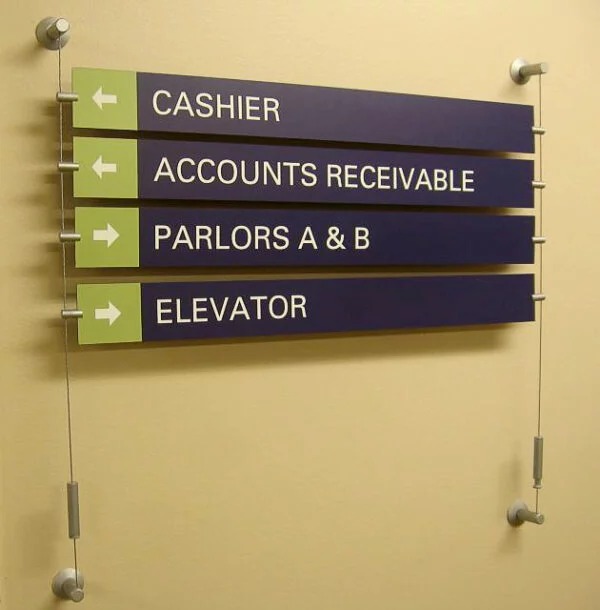


Genesis Signs & Graphics manufactures directory and wayfinding signs for visitors to navigate their way around your building.
In a fast-moving world where people expect clarity and convenience, wayfinding signs have become an essential part of every environment — from hospitals and corporate offices to schools, shopping malls, and airports. On Long Island, where communities thrive in both urban and suburban spaces, the need for effective wayfinding solutions has grown rapidly. These signs not only help people find their way but also improve accessibility, safety, and brand communication.
Wayfinding signs are designed to guide individuals through a physical space, offering visual cues that lead them from one point to another. A well-planned wayfinding system eliminates confusion, saves time, and ensures smooth movement throughout a facility.
There are four main categories of wayfinding signs:
Identification Signs – Label rooms, buildings, or areas such as “Reception,” “Restrooms,” or “Conference Room.”
Directional Signs – Use arrows or maps to show routes toward specific locations like “Exit,” “Cafeteria,” or “Parking.”
Informational Signs – Provide useful details such as hours of operation or Wi-Fi availability.
Regulatory Signs – Communicate rules, safety instructions, and restrictions like “No Entry” or “Authorized Personnel Only.”
Together, these elements create a complete navigation system that enhances both functionality and user experience.
Long Island’s landscape is a blend of corporate parks, healthcare facilities, educational institutions, shopping centers, and entertainment venues. Each of these spaces welcomes thousands of visitors daily — many of whom are unfamiliar with the layout. Without proper signage, confusion and inefficiency can quickly arise.
For example, in hospitals or clinics, time is critical. Clear wayfinding signs ensure patients reach the right department without delay. In retail environments, they guide shoppers efficiently, improving satisfaction and encouraging longer visits. For corporate offices, wayfinding contributes to professionalism and helps employees and clients navigate effortlessly.
In short, wayfinding signs are no longer optional; they are a necessity for any modern Long Island business that values customer experience and accessibility.
1. Improved Customer Experience
Visitors who can easily find their way around a space are more likely to return. Whether it’s a first-time patient, student, or shopper, clear navigation builds comfort and confidence.
2. Enhanced Brand Identity
Modern wayfinding designs often integrate company colors, logos, and fonts, turning functional signage into brand reinforcement tools. A well-designed sign system communicates attention to detail and consistency — qualities that customers subconsciously associate with trustworthiness.
3. Accessibility for All
ADA-compliant signage ensures inclusivity for people with disabilities. On Long Island, many organizations are adopting tactile letters, Braille, and high-contrast visuals to make spaces more welcoming to everyone.
4. Better Traffic Flow
Wayfinding systems reduce congestion and confusion in high-traffic areas. Whether in a busy airport terminal or an educational campus, strategic sign placement helps people move efficiently from one point to another.
5. Safety and Compliance
In emergencies, wayfinding signs play a crucial role in guiding people safely toward exits, assembly points, or emergency facilities. Properly placed illuminated exit signs and directional arrows can make a life-saving difference.
Creating an effective wayfinding system requires thoughtful planning and design. Here are a few elements to consider:
Clarity: Use concise wording and simple symbols that are easy to understand at a glance.
Consistency: Maintain uniform design elements — color, font, and icon style — throughout the entire facility.
Visibility: Signs should be placed at eye level and well-lit for day and night readability.
Durability: Use weather-resistant materials like aluminum, acrylic, or PVC for outdoor installations.
Contrast and Color: High-contrast color combinations improve legibility and help visually impaired individuals.
Placement Strategy: Signs should appear at decision points such as intersections, hallways, and entrances.
A professionally designed wayfinding system combines these factors to create seamless navigation and reinforce a brand’s identity.
Hospitals and Healthcare Facilities:
In large healthcare campuses, patients often feel anxious or disoriented. Clear directional signs reduce stress, ensuring visitors reach departments like radiology, emergency, or billing easily.
Educational Institutions:
From kindergarten to universities, clear signage helps students, parents, and staff locate classrooms, offices, and facilities, creating a sense of order and organization.
Corporate Offices:
For businesses with multiple departments or floors, professional wayfinding signs streamline navigation, improving the visitor experience and employee efficiency.
Retail and Commercial Spaces:
In malls and shopping centers, directional and identification signs enhance the shopping experience and guide customers to stores, restrooms, and exits.
Public Parks and Recreation Areas:
In Long Island’s many outdoor spaces, wayfinding signs direct visitors to trails, picnic areas, and parking zones while preserving aesthetic appeal.
Long Island businesses benefit uniquely from customized wayfinding systems. The region’s mix of modern architecture and traditional structures allows for creative signage integration — from sleek acrylic signs in corporate settings to rustic wooden directional markers in outdoor venues.
Local sign manufacturers understand the island’s environmental challenges, such as humidity, coastal winds, and sunlight exposure. They design durable, weather-resistant signs that maintain clarity and beauty for years.
Moreover, with Long Island’s growing emphasis on accessibility and sustainability, many sign makers now use eco-friendly materials and energy-efficient lighting options, aligning with modern environmental standards.
Wayfinding signs might seem like small details, but their impact on user experience and brand image is enormous. For Long Island businesses, schools, and institutions, these signs represent the intersection of functionality, design, and communication.
Investing in a well-planned wayfinding system not only helps people navigate easily but also projects your commitment to organization, inclusivity, and professionalism. In a world where first impressions matter, a clear direction can truly lead to success.
